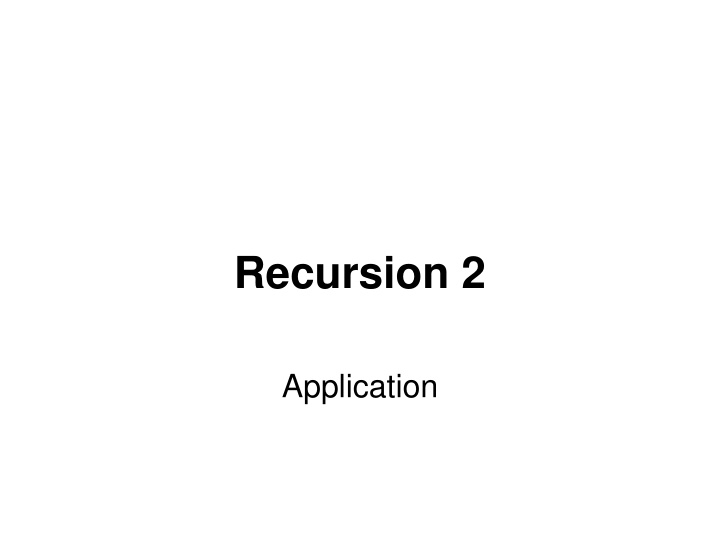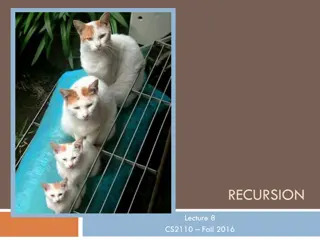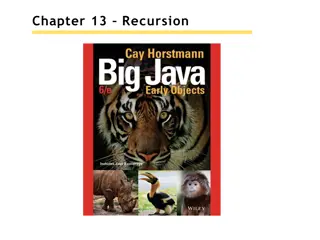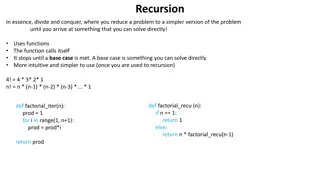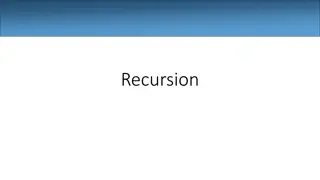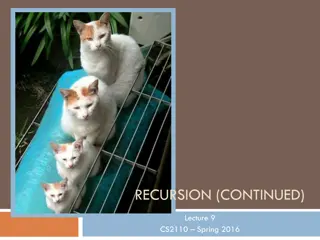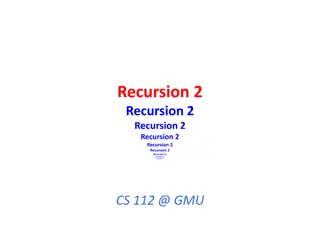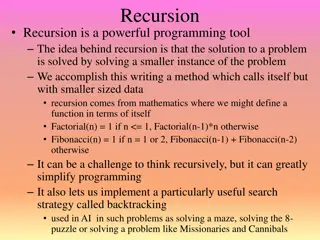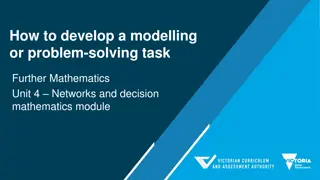Recursion in Problem Solving
Recursion plays a key role in problem solving, particularly in applications like backtracking for searching all possible solutions. Specifically, it is used in scenarios such as path searching in a labyrinth and solving the 8 Queens Problem. In this problem, the principle involves placing non-attacking queens on an 8x8 chessboard, requiring a systematic approach to exploring all possible placements. This technique is more efficient than brute force methods and involves steps being taken back when necessary to explore alternative solutions.
Download Presentation

Please find below an Image/Link to download the presentation.
The content on the website is provided AS IS for your information and personal use only. It may not be sold, licensed, or shared on other websites without obtaining consent from the author.If you encounter any issues during the download, it is possible that the publisher has removed the file from their server.
You are allowed to download the files provided on this website for personal or commercial use, subject to the condition that they are used lawfully. All files are the property of their respective owners.
The content on the website is provided AS IS for your information and personal use only. It may not be sold, licensed, or shared on other websites without obtaining consent from the author.
E N D
Presentation Transcript
Recursion 2 Application
Recursion - application Backtracking it is used to search all possible solution of the problem principle: the solution is searched step by step; if the solution is found or the next step is not possible, the step back is done it is more effective than brute force technique typical task: path searching in the labyrinth 8 Queens problem
8 Queens Problem task: place nonattacking 8 queens on 8x8 chess principle: place queen on the 1. row, 1 column place next queen on the 2. row and 3. column place next queen on the 3. row etc. if it is not possible, return to the 2. row and try move queen to the next column etc.
8 Queens Problem demonstration: 4 Queens Problem
8 Queens Problem next queen can t be placed, back step is executed
8 Queens Problem next queen can t be placed, back step is executed
Tree of searched space
it must be implemented by recursion or the searching the solution space (tracing tree deep) must be done with stack in loop states are stored/got to/from the stack loop finishes when the stack is empty
Searching Path in Labyrinth room[0][0] room[1][0]
recursive backtracking algorithm if it is possible, try to go to each world side in each room if I found exit, print path and do step back do step back, if it is not possible to go to some world side or you returned from all neighbouring rooms
How to create algorithm? We create it in pseudocode. Rules how to create recursive function: a)stop condition exit found or I can t go to next room b)simpler problem in recursive call I go to next room (found path is longer)
go_to_room(where) { if (out_of) { print_path(); return; } else { if (can_to_north) go_to_room(north); if (can_to_south) go_to_room(south); if (can_to_east) go_to_room(easth); if (can_to_west) go_to_room(west); } }
Donald Knuth Data + Algorithms = Programs Think about data structures and algorithm!
labyrinth representation width and length dynamic two-dimensional array with info about rooms typedef struct { int width, lenght; TRoom **rooms; } TLabyrinth;
room representation info if doors are opened to each world side typedef enum { CLOSED=0,OPENED=1 } TDoorState; typedef struct { TDoorState north_door; TDoorState south_door; etc; } TRoom;
how to store path (visited rooms within path) the length of the path is not known in advance back-tracking algorithm if I enter to the next room I add the room to the end, if I do step back, I remove the room from the end of the path double linked list prevention against infinity loop Boolean array with visited rooms direct test: I will not enter the room from which I came
header of recursive procedure void go_to_room(TLabyrinth *labyrinth, TWorldSides where_to_go, int x, int y, TPath *path);
Task Domino game Domino tile has two fields. Each field can be empty or it can contain 1 6 points. Tiles are put into chain so that neighbouring tiles have the same count of points in adjacent tiles. No tile can be joined to the tile with empty field. Create program which reads set of tiles from the file (each row contains pair of numbers 0 6 representing one tile), tiles with the same count of points can repeat in the file. The program writes the longest chain which can be created from the set and the count of tiles in the chain.
Divide and Conquer principle: divide state space into two (several) smaller subspaces solve the problem on each (smaller) space recursively merge solutions task: Towers of Hanoi sorting: QuickSort
